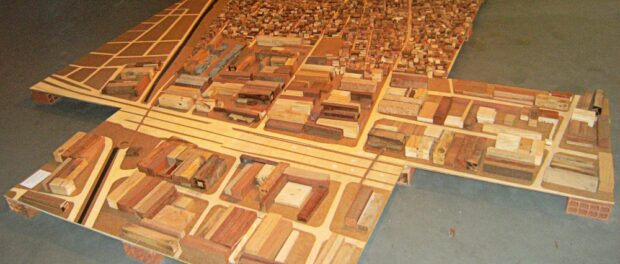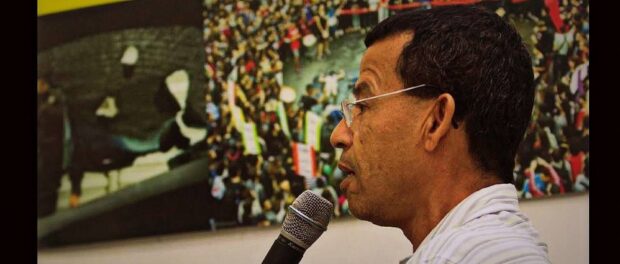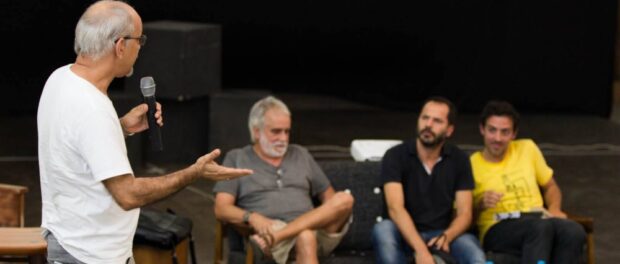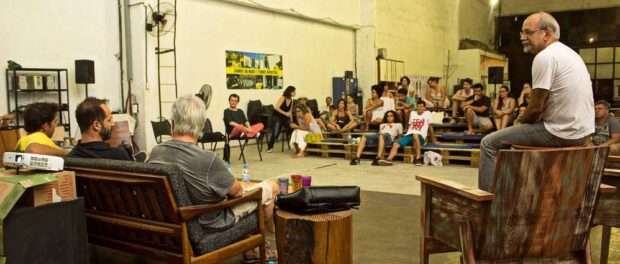
On Saturday November 1, photographer Mauro Restiffe, architect and urbanist Manoel Ribeiro and architect Pedro Évora delivered engaging presentations on the subject “When are cities finished?” for the Travessias 3 art festival in Complexo da Maré. The presentations, which took place at the Maré Art Center, were followed by a debate that was moderated by Jorge Barbosa from Observatório de Favelas.
The debate addressed specifically the transformations affecting Maré and Rio. It was the penultimate debate featured in the three-month long art festival program, that included workshops and other activities and will end on November 16.
Photographing the Maré Complex of favelas
Mauro Restiffe’s presentation focused on São Paulo, Taipei and Istanbul landscapes and shapes. His work captures modernist interiors as well as daily life portraits. In Brasília (2003) and Washington D.C (2008), Mauro snapped unconventional shots of the respective presidential election ceremonies of Luiz Inácio Lula da Silva and Barack Obama. Rigorous composition, gray shades and intense grain are his trademarks. His presentation showcased an artistic quest that linked his past productions with more recent photographs of Bologna’s streets at night, interiors of work-in-progress museums and Maré’s becos (alleyways).
For Travessias 3, Mauro Restiffe spent a week exploring the neighborhood of Maré, specifically the Nova Holanda favela. “[I am] very happy about the outcome,” Mauro said about his “direct and unfiltered” photographic experience both in the making and exhibiting of Maré’s “unrestricted complexity.”
His photographic works will be on show until the end of the Travessias exhibition, on November 16.
Cities as works in progress
In a city planning crash course, architect and urbanist Manoel Ribeiro shed light on the first steps of today’s speedy urbanism. From Roman square-based foundations to theaters and hot springs, Ribeiro gave examples of the wealthy and powerful separating themselves from the rest of society. Speaking of China’s 3-square meter family houses and Detroit’s failed project of production-based city models, Ribeiro questioned contemporary ultra-urbanism, where a fixation on constant economic growth meets inconsistently with the planet’s limited resources.
“Artists and poets cannot abandon the utopia of fairer and safer cities for everyone,” he concluded. “[Cities that are] more equal and ready–yet unfinished–in fulfilling the role assigned by human civilization.”
The cyborg city
At Travessias for the second time, Pedro Évora is the architect who leads workshops to build an ever-growing miniature of Maré, Modelo Vivo (Live Model).
Évora mentioned the ancient city of Sumerian Ur to point to the contradiction of setting limits, allowing for a growth space which will then be met, surpassed, and set again. Brasília’s challenges, he argued, show how people’s will surpasses the strictest of plans. He strongly believes in the “vitality of peripheries”: the informal overcoming the formal.
“[Cities are] a repository of inanimate things, yet an organism at the same time,” said Évora, looking for a word to define the ever-changing urban landscape.“It’s a cyborg!” he concluded.
Cities are cyborg creatures, constantly growing and shedding skins. Rio, for example, seems to have found a “vocation as a city of events,” a stage of episodic happenings; yet Pedro warned against the “dangers of a mono-use city.” Cities can live or die from tourism: tourism can fundamentally compromise a city’s function. The city can get locked, crystallized in form and use, only “ready to be photographed or bought, stripped of any interaction.”
Contesting this, Évora calls for an end of planning and instead for anarchic, collective actions which decide where cities should go or when they should end. Modelo vivo, the model of Rio de Janeiro starting from Maré, also served as a no-plan experimentation. When exhibited in São Paulo, visitors were asked to “mix it up with care”; they were free to manipulate the parts how they wished or revert to the original. What would city planning look like if everyone gave directions and no one set walls?
The importance of understanding favelas
Observatório de Favelas founder Jorge Barbosa opened the debate with a thought-provoking statement: “Human beings are unfinished subjects, cities should be unfinished like ourselves.” However, this call for dreams and desires is marked by conflicts. He continued “The formal city finds itself ready, finished, done; peripheries are inventing forms and functions. [Formal] cities are meant to last forever; [informal] cities are re-inventing, re-constructing themselves.”
Évora described favelas as places with “sustainability, vitality, that are represented more by potentialities than the things they lack.” In terms of energy crisis and limited resources, favelas were also described as most resilient because of their history of resistance.
Restiffe praised favelas for their “level of organization” and good structure, concluding they are “very efficient regardless of all their deficiencies” and that “there’s a lot to learn from them.”
Ribeiro defined favelas as “[an] urbanistic expression of Brazilian social debt.” He rejected the market’s “invisible hand” as a feasible planner: “Favelas are nuclei of resistance against the centrifugal forces of market which want to throw away the poorer periphery,” he said. “Favelas, if well understood, are spaces of enrichment of urban culture. If misunderstood, they are spaces to be removed and gentrified.”
The audience joined in the debate by asking about the right to the city, the militarization of the favelas and the fundamental challenges favelas face in being recognized by society.
Resident José Francesco, originally from Minas Gerais and Maré resident since 1985, pointed out that “favela residents are great shapers of ideas, strong men and brave women, who built all this world that we inhabit today. It is our right to stay, as we are discussing and achieving more and more.” He defined his personal feelings of security in Maré, a “security that starts with culture and education.”

Welcoming José’s comments, Ribeiro concluded the event by remarking on the limits of planning, the need for diversity, and the need for popular ingenuity. Restiffe promised to come back to photograph Maré again and Évora raised the stakes inciting the audience to challenge market forces and mitigate the effects of gentrification.
Barbosa’s concluding words were powerful: “Let’s make a masterpiece that shall be greater than the human, it will be a city that is black, beautiful, generous, diverse in gender and sexual orientation, a city filled with our human manifestations, that fits all of us, but not the ferocity of capitalism.”


